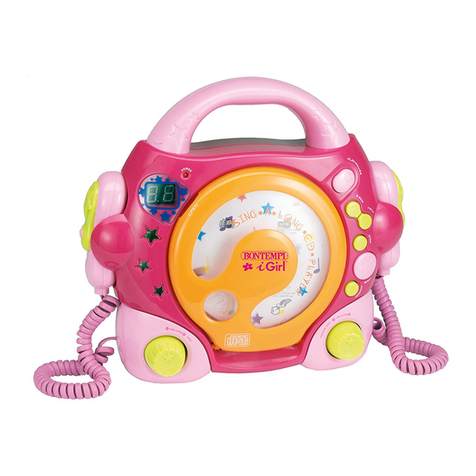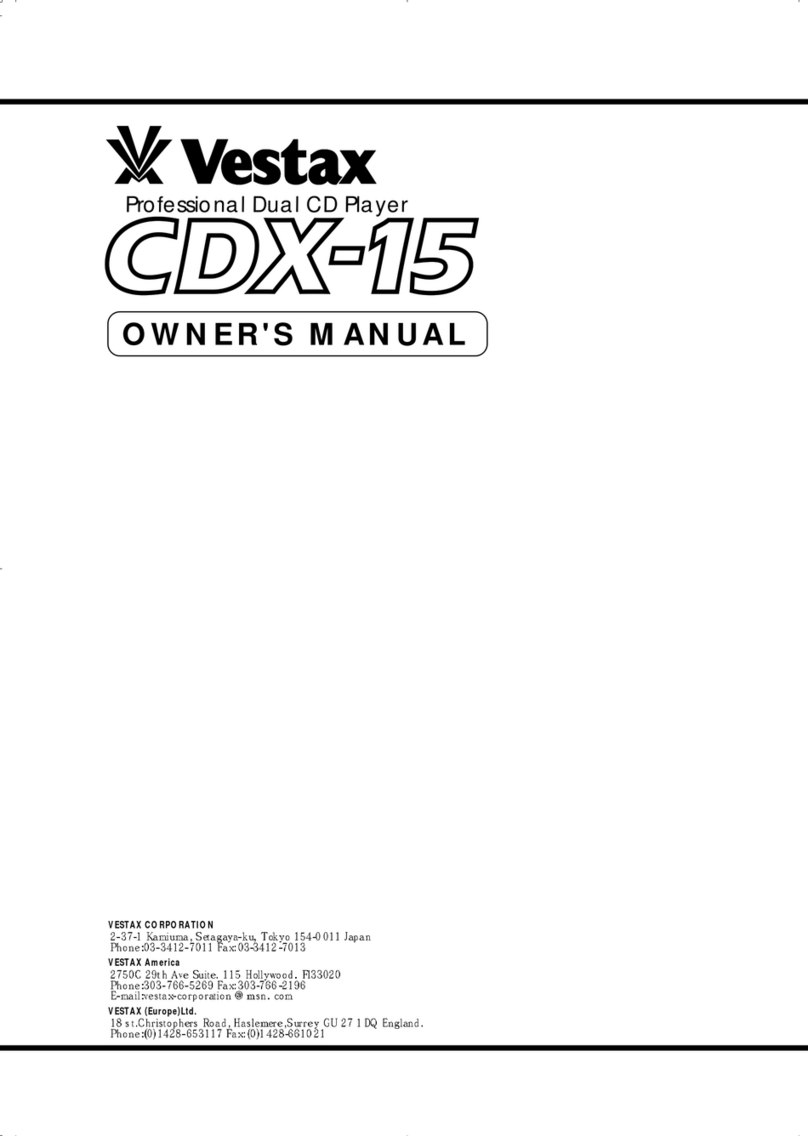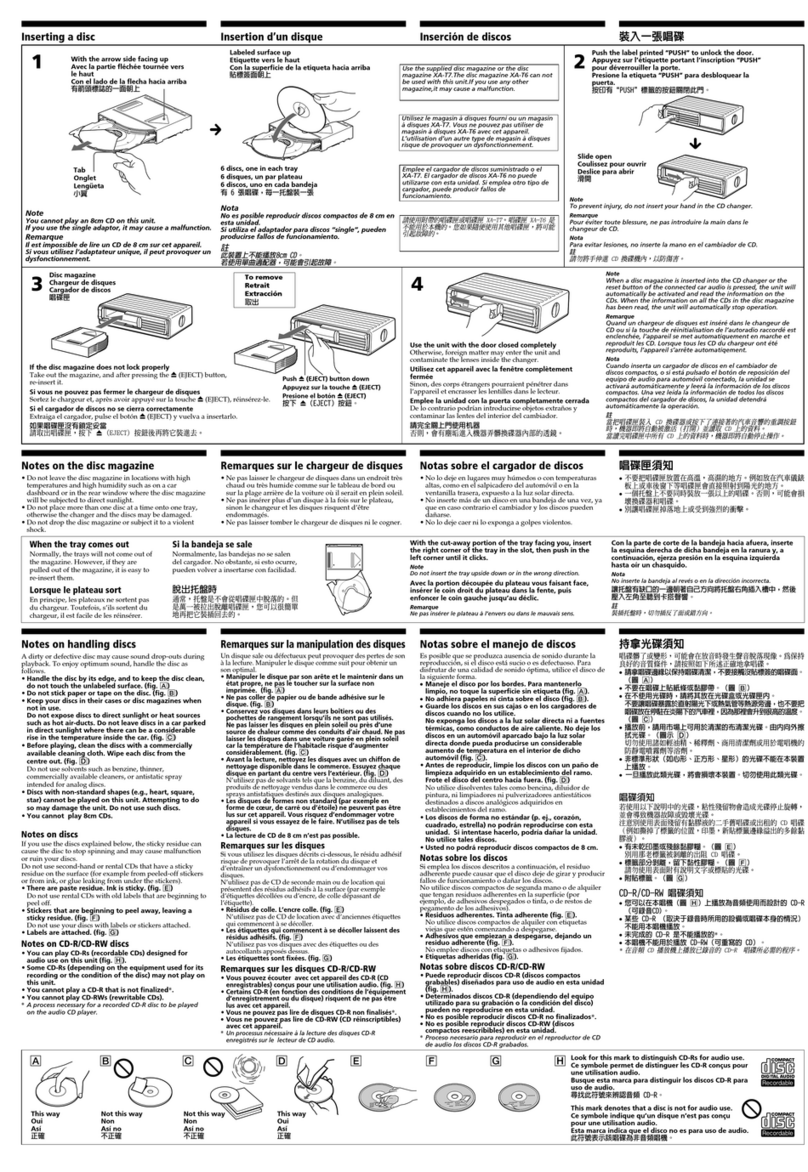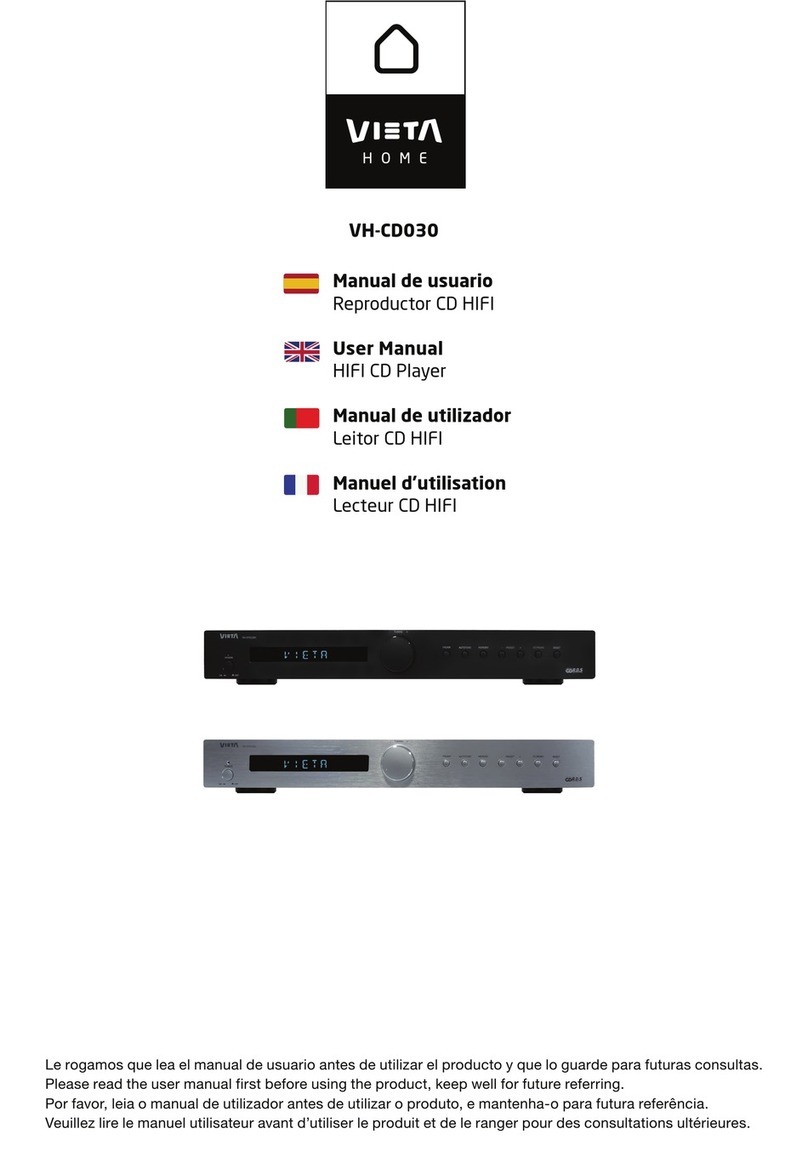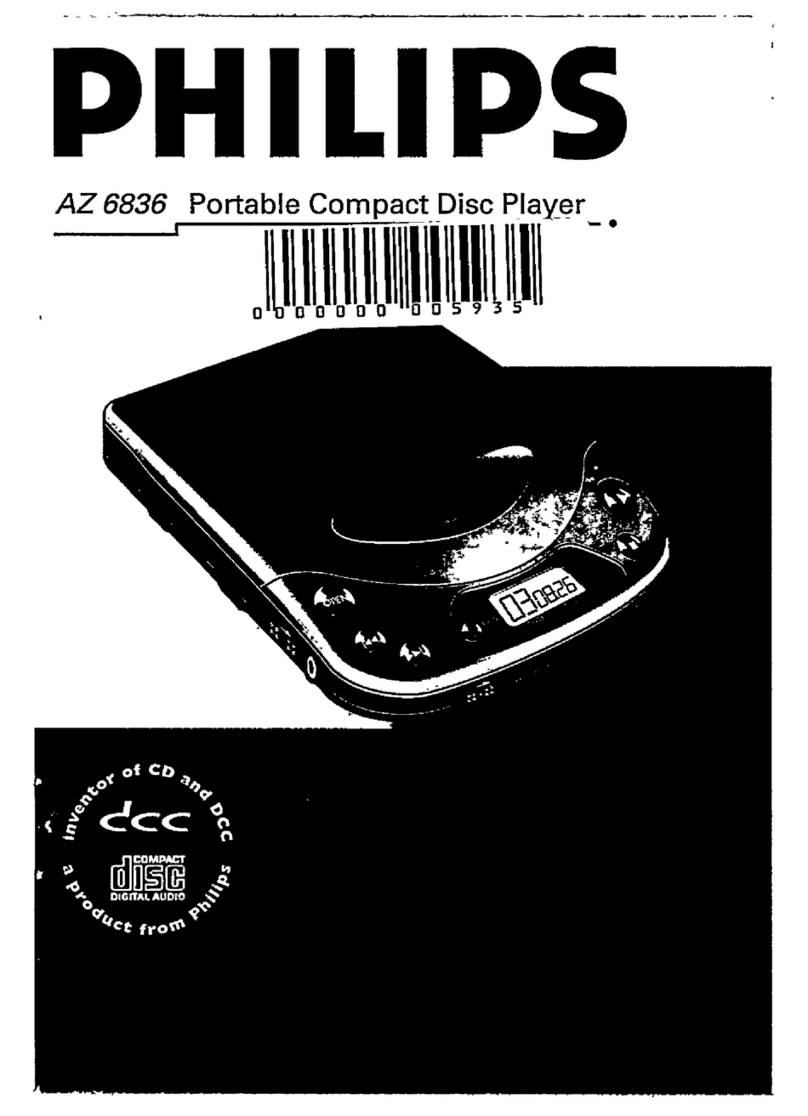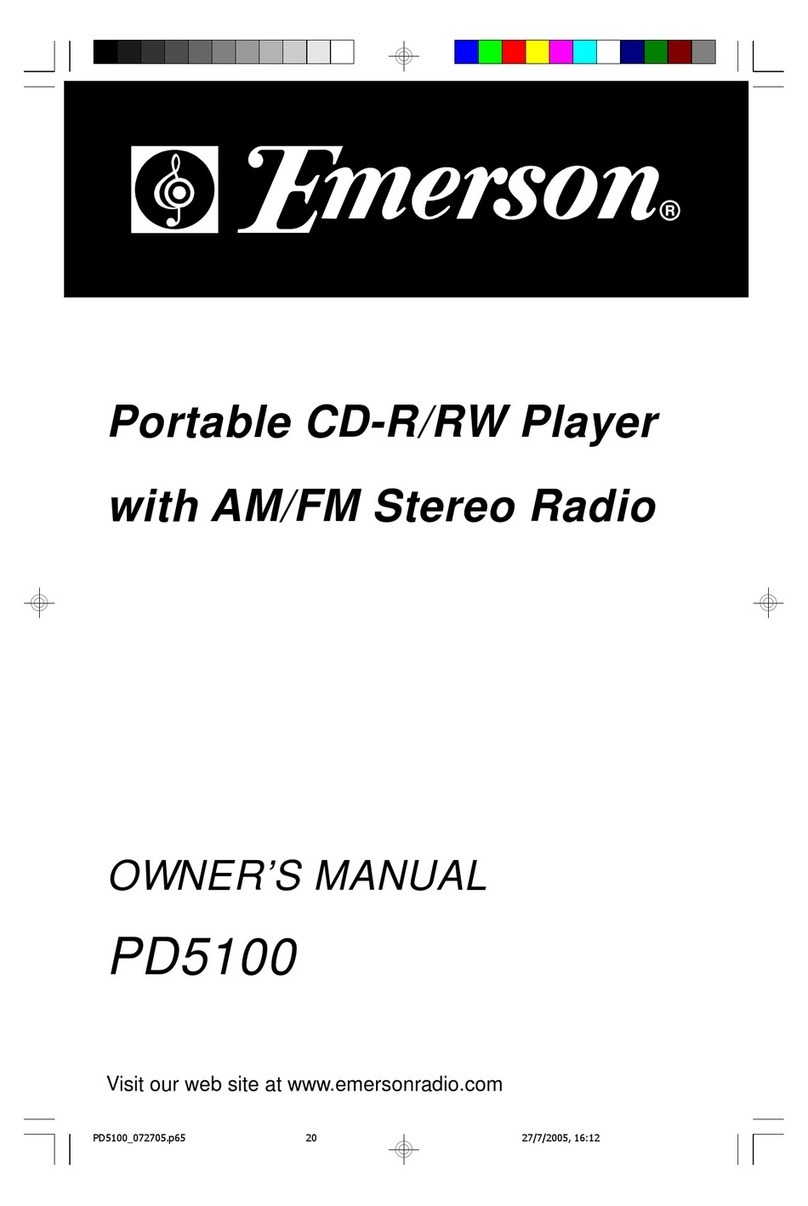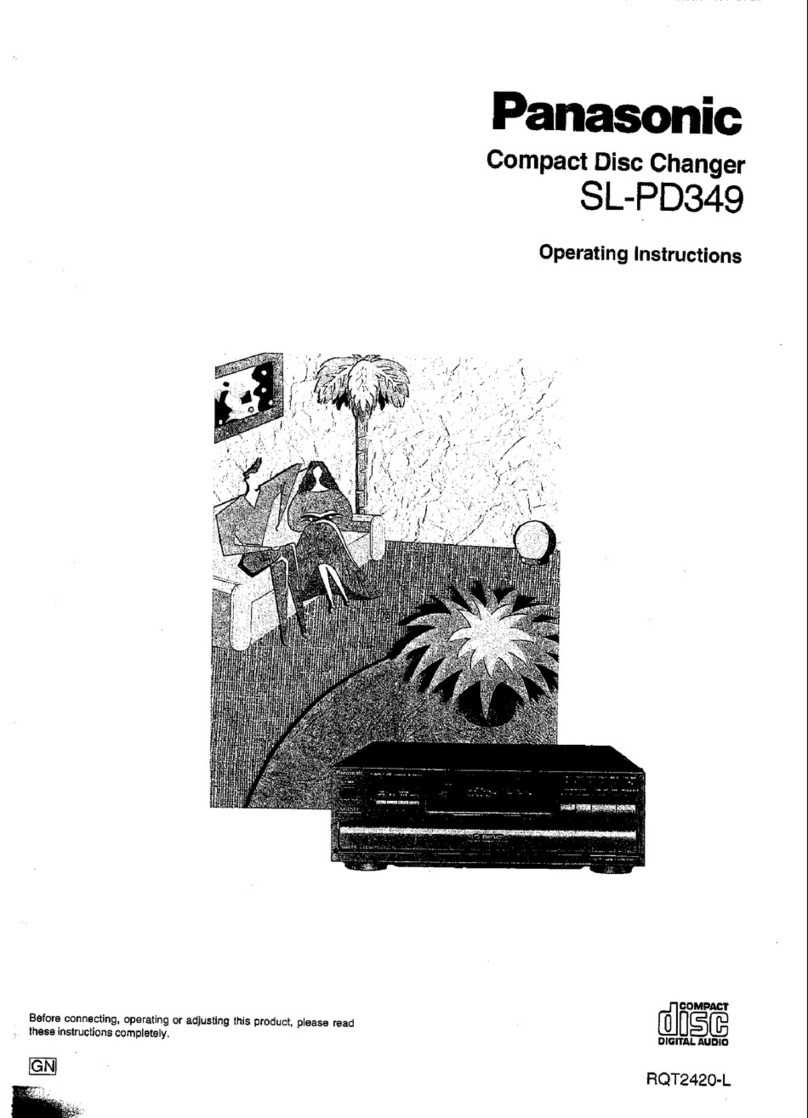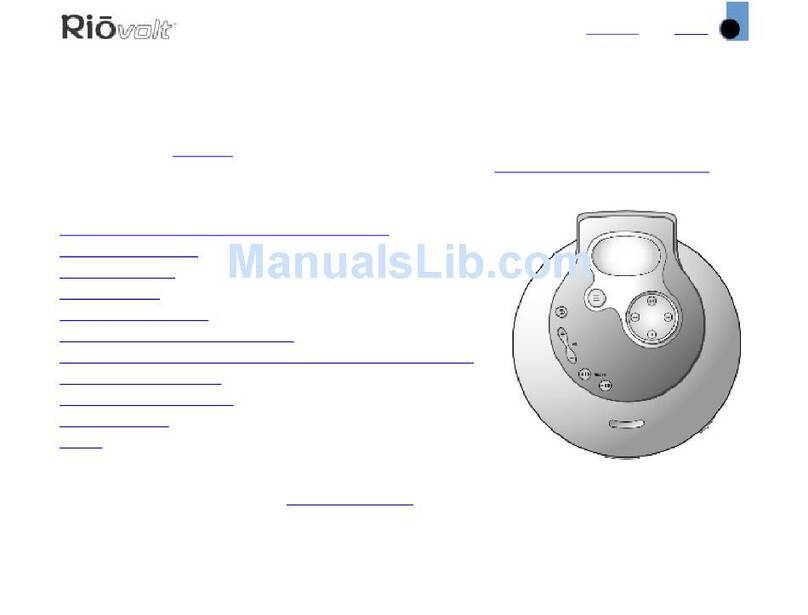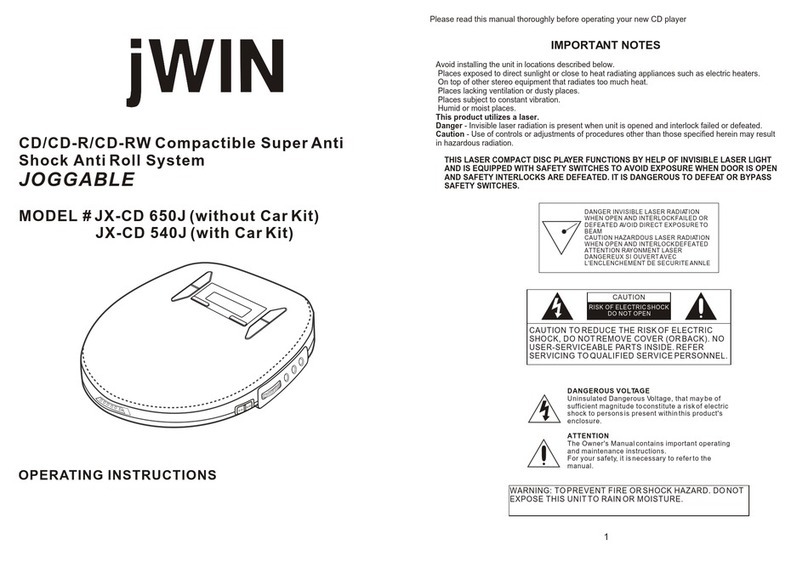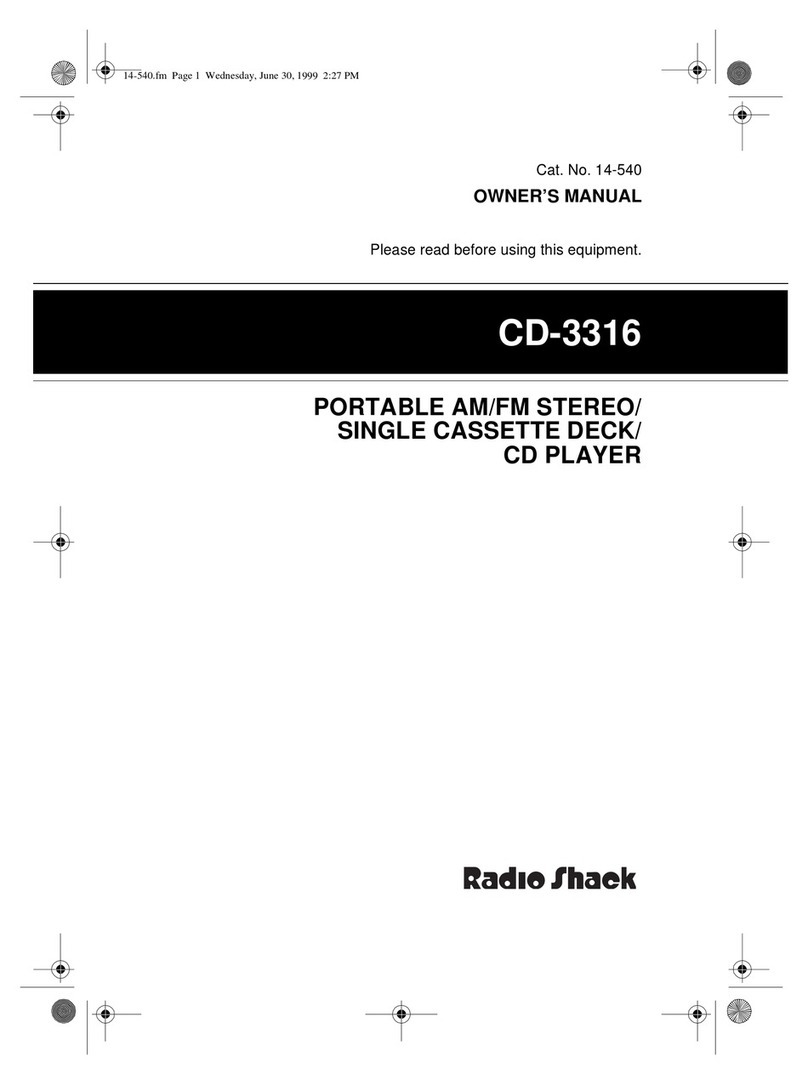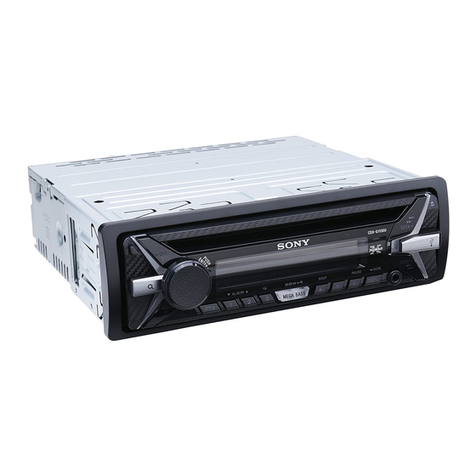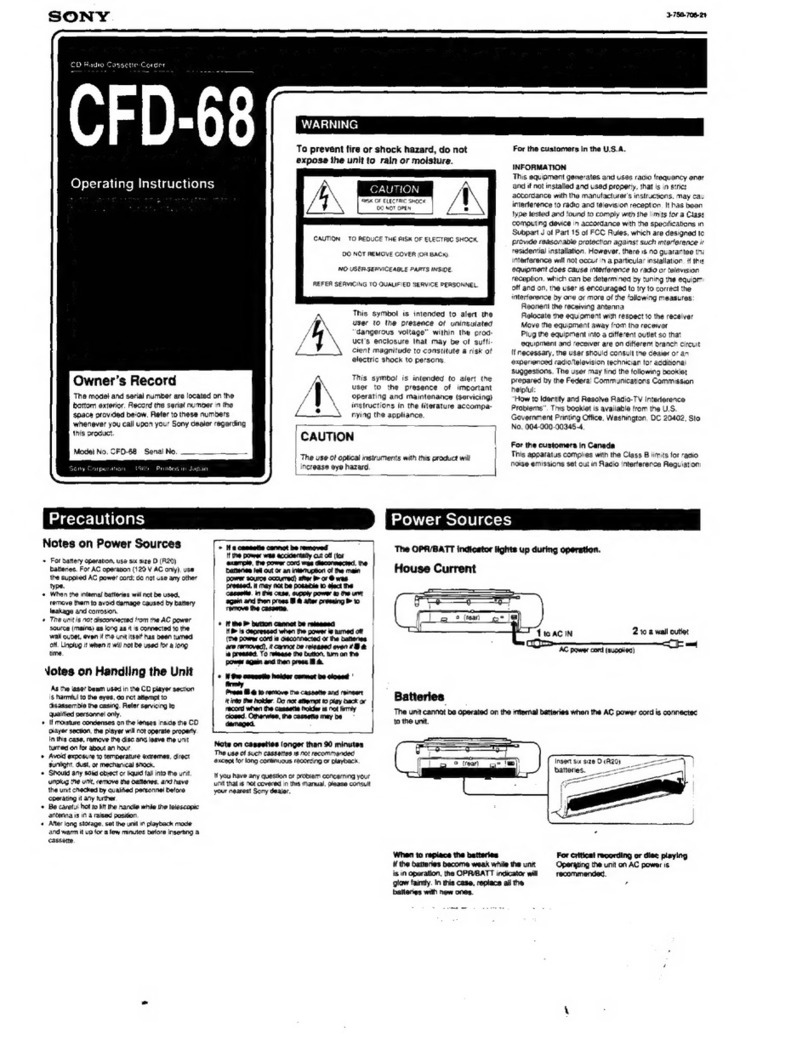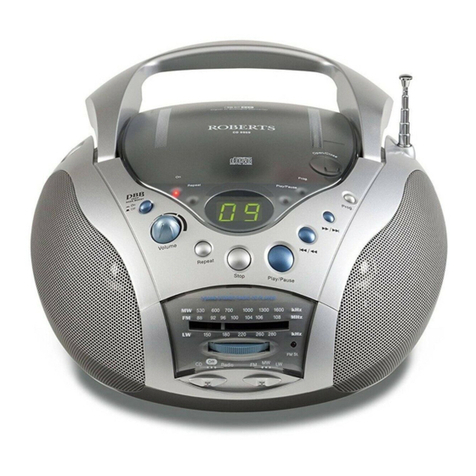Bontempi 43 9980 User manual

CD Player
with 2 singalong microphones
and USB functions
43 9972
43 9980
GB - OWNER’S MANUAL ................2
F - MANUEL D’ INSTRUCTIONS.........7
D - BEDIENUNGSANLEITUNG...... 12
E - LIBRO DE INSTRUCCIONES........17
P - MANUAL DE INSTRUÇÕES.........22
I - MANUALE DI ISTRUZIONI........ 27

2
E N G L I S H
1. Open the CD compartment lifting the lid from
the OPEN side
2. Remove the protection cardboard
4. Close the CD door
Unscrew and remove the battery door
HOW TO INSERT A COMPACT DISC (CD)
HOW TO OPEN THE BATTERIES DOOR
3. Insert a CD with the printed side outward
Note: Do not touch the lens

3
POWER SUPPLY
Battery supply
Open the battery compartment. Insert 4 x 1,5 V batteries R14/C (not supplied).
Re-fit battery cover. Replace batteries when the quality of sound becomes bad. Use
alkaline batteries to obtain a longer duration.
ATTENTION - BATTERY CARE: • Non-rechargeable batteries are NOT to be recharged. • Re-
chargeable batteries must be removed from the product before being charged. • Rechargeable
batteries are only to be charged under adult supervision. • Different types of batteries or new and
old batteries are not to be mixed. • Use only batteries of the same or equivalent type. • Batteries
are to be inserted with correct polarity. • Remove exhausted batteries to prevent leakage. • Do
not short circuit supply terminals. • Remove batteries during long periods of non-use.
Mains supply
The instrument can be supplied by the AC/DC (Vdc =6V / I = 600 mA)
negative central adapter (supplied) conforms to national and international safety
regulations covering electrical appliances. • The toy is not intended for children under
3 years old. • The toy must only be used with the recommended adaptor • The toy is to be
disconnected from the adaptor before cleaning • The mains adaptor is NOT a toy.
WASTE DISPOSAL STANDARDS
For information regarding the disposal of the items mentioned here below, please refer to Council Administration office
regarding specialised waste collection centres.
1. DISPOSAL OF BATTERIES - Protect the environment. Batteries can be recycled and should be disposed
of in the right containers. Do not throw them in the ordinary rubbish.
2. PACKAGING DISPOSAL -Take the paper, cardboard and corrugated board to the appropriate waste collection centres.
Plastic material must be placed in the relevant collection containers.
The symbols indicating the various types of plastic are:
Key for the different types of plastic materials:
• PET = Polyethylene terephtalate • PE= Polyethylene, code 02 for PE-HD, 04 for PE-LD • PVC= Polyvinyl chloride • PP=
Polypropylene • PS= Polystyrene, Polystyrene foam • O= Other polymers (ABS, Laminates, etc.)
3. DISPOSING OF ELECTRICAL APPLIANCES - The wheelie bin symbol with a cross indicates that the product must
not be disposed of in the domestic waste at the end of its useful life. Instead, it should be taken to your nearest
designated collection point or recycling facility. Alternatively, check with your retailer and return the product when
buying a replacement, on a one-to-one basis or as free of charge in case the size is smaller than 25 cm. Appro-
priate disposal promotes the recycling of parts and materials, as well as helping to protect the environment and
human health. Under current legislation, strict penalties are enforced against those disposing of products illegally.
For more information about the collection of special waste, contact your Local Authority.
SOCKET FOR HEADPHONES
This socket allows you to connect a STEREO headphones (not included).
SOCKET USB
This socket allows you to connect a USB flash drive (not included).
SWITCH ON AND SWITCH OFF
To switch on the recorder turn the POWER OFF ⊖VOLUME ⊕knob and adjust
the volume. After use, turn the knob back to the OFF position to prevent unnecessary
consumption of batteries.
01
PET
02
PE
03
PVC
05
PP
06
PS
07
O

4
HOW TO LISTEN TO A CD TUNE
1. Switch on by turning the POWER OFF
⊖VOLUME ⊕button.
2. Open the CD compartment lifting the lid
from the OPEN side (remove the cardbo-
ard protection disc if present).
3. Insert the CD with the printed side facing
outwards.
N.B.: the CD can contain both AUDIO and
MP3 tunes.
4. Close the lid manually.
5. The first tune plays automatically. The
number of tunes contained in the CD ap-
pears on the display and, alternatively,
the tune number being played and pro-
gress in minutes and seconds.
6. Adjust the volume by turning the POWER
OFF ⊖VOLUME ⊕button.
7. To pause the tune or start it again from
the same position press PLAY/PAUSE.
8. To stop listening press STOP.
HOW TO LISTEN TO A TUNE FROM USB FLASH DRIVE
1. Insert the USB flash drive containing the MP3 files in the USB socket on the back of the device.
2. Select USB mode by pressing CD/USB; “USb” appears on the display
3. The first tune plays automatically. The tune number being played and progress in minutes and seconds appears
on the display alternatively.
4. Adjust the volume by turning the POWER OFF ⊖VOLUME ⊕button.
5. To pause the tune or start it again from the same position press PLAY/PAUSE.
6. To stop listening press STOP.
SELECTING PIECES
To select the music pieces use the two BACK and NEXT buttons, the display will show the number of the chosen piece.
Keeping the buttons pressed continuously. The piece being played will go forwards or back fast.
SELECT MP3 TUNES FOLDER
MP3 tunes can be grouped in a folder in the CD or Flash Drive. To select the desired folder press FOLDER UP.
REAPEATING A TUNE
By pressing the P-MODE button once the piece being played will be repeated without interruption (the symbol
flashes on the display).
Pressing the P-MODE button twice all the pieces will play without interruption (the symbol does not flash on
the display).
PROGRAMMING TUNES
Creates a personalised program of the pieces.
Before programming you have to press STOP.
Press the PROGRAM button; “P01” appears on the display.
Choose the piece with BACK/NEXT buttons, press the PROGRAM button again to store the chosen piece. Repeat
the operation to store other pieces.
On pressing PLAY/PAUSE tunes programmed will be played in sequence.
N.B. Pressing the STOP button the music stops. Pressing it again the program is reset.
POWER
indicator light
MICROPHONE
SWITCH
PROGRAMMING TUNES
SELECT MP3 TUNES FOLDER
SELECTION CD/USB
REPEAT PIECE
POWER ON OFF
VOLUME
MICROPHONE
VOLUME
MICROPHONE
SWITCH
STOP
DISPLAY SELECT PIECES
PLAY /PAUSE
PIECES

5
CLEANING THE CASE
Rub with a soft cloth. If the case is very dirty, dampen the cloth with a natural detergent solution and water, then rub.
CLEANING THE LENS OF THE LASER RAY
Switch the device off before cleaning. If the lens is dirty there will be skips during playback and, if it is very dirty,
the CD may not function. Open the CD compartment and clean the lens as follows:
a. DUST OR DIRT
Use a brush and jet of air used to clean camera lenses. Blow the lens repeatedly, and then rub gently with the
brush to remove any dust. Blow on the lens again.
b. FINGER PRINTS
Use a ball of cotton wool to remove fingerprints from the lens. Start to clean from the centre towards the edge.
Press lightly on the lens. Do not allow it to exit from its axis.
CLEANING THE DISC
When the disc is dirty, clean it with a special cloth.
Always clean from the centre towards the outside.
1. Clean the device with a damp soft cloth, using only delicate soap and water. Do not use more aggressive deter-
gents such as petrol, solvents or similar products as they damage the surface of the casing.
2. If there is a problem with the device, consult the troubleshooting guide shown below before requesting technical
assistance.
ATTENTION
• Never leave the device in direct sunlight, in a car parked in the sun, or near a heat source. (Excessive heat may
cause deformation, change in colour and malfunctioning of the device).
• The toy and adapter must be periodically checked by an adult, in order to verify any possible damages.
WARNING
1. THIS LASER COMPACT DISC PLAYER FUNCTIONS BY HELP OF INVISIBLE LASER LIGHT AND IS EQUIPPED WITH
SAFETY SWITCHES TO AVOID EXPOSURE WHEN DOOR IS OPEN AND SAFETY INTERLOCKS ARE DEFEATED. IT IS
DANGEROUS TO DEFEAT OR BYPASS SAFETY SWITCHES.
2. NEVER LOOK DIRECTLY AT THE RAY OR LOOK DIRECTLY AT IT USING OPTICAL INSTRUMENTS.
3. INVISIBLE LASER RADIATION CLASS 1M WHEN OPEN).
4. UNINSULATED DANGEROUS VOLTAGE, THAT MAY BE OF SUFFICIENT MAGNITUDE TO CONSTITUTE A RISK OF
ELECTRIC SHOCK TO PERSONS, IS PRESENT WITHIN THIS PRODUCT’S ENCLOSURE.
5. IF THE CD PLAYER UNDERGOES BLOWS OR SUDDEN MOVEMENTS, THE SOUND COULD BE FAULTY.
6. THIS CD PLAYER IS NOT EQUIPPED WITH AN ANTI-SHOCK ELECTRONIC MEMORY.
MAINTENANCE AND REMARKS
MICROPHONES
The instrument comes with 2 microphones which can be used individually or together
with or without the CD in operation.
Turn on the microphone positioning the cursor upwards.
Speak close to the microphone; the amplified voice will be diffused by the loudspeaker.
Adjust the volume turning the ⊖VOLUME ⊕MIC knob.
NOTE: Do not bring the microphone too close to the loudspeaker. This can cause noisy
interference.

6
TROUBLE SHOOTING GUIDE
Problem
The CD does not
function with the
network adaptor.
The device is
switched on but the
volume is low or
non-existent.
The device works
but the music
cannot be heard.
The CD does not
turn.
The CD does not
playback.
Music cannot be
heard through the
headphone
(not included).
Irregular
functioning.
Probable cause Solution
- Try and connect the device to another
socket.
- Connect the device to another socket.
- Do not use a socket that is controlled
by a wall switch.
- Check.
- Control the under part of the disc and
clean if necessary with a soft cloth;
always work from the centre to the
edge of the CD.
- Increase the volume with the relative
control.
- Replace the batteries with new
alkaline-type.
- Replace the batteries with new
alkaline-type.
- Replace the batteries with new
alkaline-type.
- Remove the batteries and insert new
ones into the correct position as
indicated in the compartment.
- Re-insert the CD correctly.
- Close the CD compartment.
- Try using another disc.
- Disc: clean with a soft cloth
(see cleaning of the lens).
- Re-insert the headphone plug correctly.
- Increase the volume.
- Replace the batteries with new
alkaline-type.
- Try with another disc.
- Clean or replace the disc.
- The device is disconnected from the
AC socket.
- The AC socket is not supplying
current.
- The AC socket is controlled by a wall
switch that is in the OFF position.
- The AC adaptor is not correctly
inserted into the socket.
- The disc is dirty or faulty.
- The volume is at minimum.
- The batteries are flat.
- The batteries are flat.
- The batteries are flat.
- The batteries have been inserted
incorrectly.
- The disc has been inserted incorrectly.
- The CD compartment is not closed
correctly.
- The disc is dirty or damaged.
- Moisture or condensation has
collected on the disc or lens.
- The headphone plug has not been
inserted correctly.
- The VOLUME control is set at
minimum.
- The batteries are flat.
- The disc is damaged.
- The disc is dirty or damaged.
TROUBLE SHOUTING GUIDE
ATTENTION: in the case of malfunctioning remove and re-insert the batteries

7
1. Ouvrir la porte en correspondance de l’inscrip-
tion OPEN
2. Enlever, s’il y a lieu, le disque de protection en
carton
4. Fermer la porte manuellement
Dévisser et enlever la porte du boîtier piles
COMMENT INTRODUIRE UN COMPACT DISC (CD)
COMMENT OUVRIR LE BOITIER PILES
3. Insérer le CD avec le côté imprimé tourné vers
l’externe
F R A N Ç A I S
N.B. Ne pas touches les lentilles

8
ALIMENTATION
Alimentation par piles
Ouvrir l’emplacement porte-piles. Brancher 4 piles de 1,5V type R14/C (non
fournies) et remettre le couvercle. Substituer les piles quand la qualité du son devient
mauvaise. Utiliser des piles alcalines pour obtenir une longue durée.
CONSEILS POUR L’UTILISATION DES PILES: • Enlever les piles déchargées de l’emplacement
porte-piles. • NE PAS recharger des piles qui ne sont pas “rechargeables”. • Pour recharger les
piles, les enlever de leur emplacement. • Recharger les piles avec la supervision d’un adulte. •
Insérer les piles avec la polarité correcte. • Ne pas utiliser des types de piles différents ou des
piles neuves et piles déchargées en même temps. • Utiliser seulement des piles du type recom-
mandé ou équivalentes. • Ne pas court-circuiter les terminaux d’alimentation. • Enlever les piles
quand l’instrument n’est pas utilisé pendant une longue période.
Alimentation sur secteur
L’instrument peut être alimenté avec l’adaptateur de réseau fourni: Vdc = 6V;
I = 600 mA (terminal negatif central). Cet appareil est conforme aux
normes nationales et internationales concernant la sécurité électrique.
• Le jouet ne convient pas aux enfants de moins de trois ans. • Le jouet doit être utilisé avec
l’adaptateur de réseau conseillé. • Le jouet doit être débranché de l’adaptateur avant un
éventuel nettoyage. • L’adaptateur sur secteur N’EST PAS un jouet.
REGLES POUR ECOULEMENT DES ORDURES
Pour l’écoulement des matériaux indiqués ci-dessous, se renseigner auprès des Administrations Communa-
les au sujet des centres d’écoulement spécialisés.
1. ECOULEMENT DES PILES: Pour aider à la protection de l’environnement ne pas jeter les piles déchargées
avec les déchets journaliers, mais dans des conteneurs spéciaux situés dans les centres de ramassages.
2. ECOULEMENT DES EMBALLAGES - Remettre les emballages en papier, carton et carton ondulé dans les centres d’écou-
lement spécifiques. Les parties en plastique de l’emballage doivent être placées dans les conteneurs pour la récolte prévus
à cet effet.
Les symboles qui repèrent les différents types de plastique sont:
Légende relative au type de matériau plastique:
PET= Polyéthylène téréphtalate • PE= Polyéthylène, le code 02 pour PE-HD, 04 pour PE-LD • PVC= Chlorure de Polyvinyle
• PP= Polypropylène • PS= Polystyrène, Polystyrène expansé • O= Autres polymères (ABS, Couplés, etc.)
3. DISPOSITION POUR APPAREILS ÉLECTRIQUES - Le symbole de la poubelle à roues avec une croix indique
que le produit ne doit pas être déposé dans les ordures ménagères à la fin de son cycle. Il doit être mis dans un
point de collecte ou de recyclage approprié. A défaut, vérifier avec votre revendeur et retourner le produit lors de
l’achat du produit de remplacement ou, si la dimension est inferieur à 25 cm, on peut le retourner gratuitement.
La disposition appropriée promeut le recyclage des parties et des matériels, aussi bien quel ‘aide pour protéger l’environ-
nement et la santé humaine. Conformément à la législation actuelle, des pénalités strictes sont faites contre ceux disposant
des produits illégalement. Pour plus d’informations sur la collecte de déchets spéciaux,
contacter la Collectivité locale.
PRISE POUR CASQUE
Cette prise permet le branchement d’un casque STEREO (non fourni).
PRISE USB
Cette prise permet le branchement d’une clé USB flash drive (non fournie).
MISE EN MARCHE ET ARRET
Pour allumer l’enregistreur tourner le bouton POWER OFF ⊖VOLUME ⊕et régler
le volume. Après utilisation, pour éviter de consommer inutilement les batteries,
tourner le bouton dans la position OFF.
01
PET
02
PE
03
PVC
05
PP
06
PS
07
O

9
COMMENT ÉCOUTER UN CD
1. Allumer en tournant le bouton POWER
OFF ⊖VOLUME ⊕.
2. Ouvrir le porte-CD en tirant sur le couver-
cle qui correspond à l’inscription OPEN
(enlever, s’il y a lieu, le disque de protec-
tion en carton).
3. Insérer le CD avec le côté imprimé tourné
vers l’externe. N.B.: le CD peut contenir
aussi bien des morceaux AUDIO que MP3.
4. Fermer la porte manuellement.
5.
Le premier morceau est exécuté automati-
quement ; sur l’écran, apparaît le nombre
des morceaux contenus dans le CD et, al-
ternativement, le numéro du morceau en
exécution et l’avancement des minutes et
des secondes
.
6. Régler le niveau du volume en tournant le
bouton POWER OFF ⊖VOLUME ⊕.
7.
Pour mettre en pause le morceau ou pour
le faire repartir du même endroit, presser la
touche
PLAY/PAUSE.
8. Pour arrêter la lecture appuyer sur STOP.
COMMENT ÉCOUTER UN MORCEAU D’UNE CLÉ USB FLASH DRIVE
1. Insérer la clé USB flash drive contenant des fichiers MP3 dans la prise USB positionnée à l’arrière de l’instrument.
2. Sélectionner la modalité USB en pressant la touche CD/USB ; l’écran affiche: “USb”
3. Le premier morceau est exécuté automatiquement; l’écran affiche alternativement le numéro du morceau et l’a-
vancement des minutes et des secondes.
4.
Régler le niveau du volume en tournant le bouton POWER OFF ⊖VOLUME ⊕
.
5. Pour mettre en pause le morceau ou pour le faire repartir du même endroit, presser la touche PLAY/PAUSE.
6. Pour arrêter la lecture appuyer sur STOP.
SELECTION DES MORCEAUX
Pour sélectionner les morceaux musicaux utiliser les deux touches BACK et NEXT; l’afficheur indique le numéro du
morceau choisi. En tenant les touches enfoncées on peut avancer ou retourner en arrière dans le morceau en cours.
SÉLECTION DOSSIER MORCEAUX MP3
Les morceaux MP3 peuvent être regroupés dans un dossier à l’intérieur du CD ou de la clé USB Flash Drive. Pour sélection-
ner le dossier souhaité, presser la touche
FOLDER UP.
RÉPÉTITION MORCEAU
En appuyant une seule fois sur la touche P-MODE le morceau en cours est répété sans interruption (le symbole
clignote sur l’écran).
En appuyant deux fois sur la touche P-MODE tous les morceaux sont exécutés sans interruption (le symbole
ne clignote pas sur l’écran).
PROGRAMMATION MORCEAUX
Permet de programmer une liste personnalisée de morceaux.
Avant d’effectuer la programmation, il est nécessaire de presser la touche
STOP.
Appuyer sur la touche PROGRAM;
l’écran affiche
“P01”.
Choisir le morceau souhaité avec les touches BACK et NEXT, appuyer encore une fois sur la touche PROGRAM pour
mémoriser le morceau choisi. Répéter l’opération pour mémoriser d’autres morceaux.
En pressant la touche
PLAY/
PAUSE
, les morceaux programmés seront exécutés en séquence.
Faire Attention: En appuyant sur la touche STOP on arrête l’exécution. En appuyant une autre fois sur la même
touche on met à zéro le programme.
Voyant POWER
INTERRUPTEUR
MICROPHONE
PROGRAMMATION DES MORCEAUX
SÉLECTION DOSSIER MORCEAUX MP3
SELECTION CD/USB
REPETITION DU MORCEAU
ALLUMER
ETEINDRE
VOLUME
VOLUME DU
MICROPHONE
INTERRUPTEUR
MICROPHONE
STOP
DISPLAY SELECTION DES MORCEAUX
LECTURE/PAUSE
MORCEAUX

10
MICROPHONE
L’appareil est pourvu de deux microphones qui peuvent être utilisés séparément ou en même
temps, avec ou sans le lecteur CD en fonction.
Allumer le microphone en positionnant le curseur vers le haut.
Parler tout près du microphone; la voix, amplifiée, sera diffusée par le haut-parleur.
Régler le niveau du volume en tournant le bouton ⊖ VOLUME ⊕MIC.
ATTENTION : Eviter de trop approcher le microphone du haut-parleur. Cela pourrait causer de
interférences désagréables.
ENTRETIEN ET DIVERS
NETTOYAGE DU BOITIER
Nettoyer avec un chiffon doux. Si le boitier est très sale, humidifier le chiffon avec une solution délicate d’eau et de
savon, et nettoyer en frottant.
NETTOYAGE DE LA LENTILLE DU RAYON LASER
Avant de procéder au nettoyage, éteindre l’appareil. Si la lentille est sale il y aura des sauts pendant l’écoute, mais
si elle est très sale, le CD pourrait ne pas fonctionner. Ouvrir le couvercle du plateau porte-CD et nettoyer la lentille
comme indiqué ci-dessous :
a. POUSSIERES OU PARTICULES DE SALETE
Utiliser une brosse et un jet d’air qu’on utilise pour les objectifs des appareils photo. Souffler plusieurs fois sur la
lentille, et frotter délicatement avec la brosse pour enlever la poussière, souffler de nouveau sur la lentille.
b. EMPREINTES DIGITALES
Pour enlever les empreintes digitales de la lentille, utiliser un morceau de coton en commençant à nettoyer du
centre vers l’extérieur. Appuyer légèrement sur la lentille en évitant de forcer pour ne pas la faire sortir de l’axe.
NETTOYAGE DU DISQUE
Lorsque le disque se salit, le nettoyer avec un chiffon spécial.
Le nettoyage se fait toujours du centre vers l’extérieur.
1. Nettoyer l’appareil avec un chiffon doux et humide avec un peu d’eau et de savon délicat. Ne pas utiliser de
détergents agressifs comme l’essence, les solvants ou des produits similaires qui pourraient endommager la
surface du boîtier.
2. Si un problème survient à l’appareil, consulter le guide aux solutions des problèmes indiqué ci-après avant d’ap-
peler le service après vente.
ATTENTION
• Ne pas laisser l’appareil sous la lumière directe du soleil, dans une voiture stationnée en plein soleil, ou près de
sources de chaleur. (La chaleur excessive peut causer des déformations à l’appareil, des changements de couleur
et provoquer un mauvais fonctionnement.)
• Le jouet et l’adaptateur doivent être contrôlés périodiquement par un adulte, afin de vérifier des dommages
eventuels.
ATTENTION
1. CE LECTEUR DE CD FONCTIONNE AVEC L’AIDE D’UN RAYON LASER INVISIBLE ET EST DOTÉ D’ INTERRUPTEURS
DE SÉCURITÉ AFIN D’EVITER L’EXPOSITION AU RAYON QUAND LE COUVERCLE EST OUVERT ET LES DISPOSITIFS
DE BLOCAGE SONT ANNULÉS. IL EST DANGEREUX D’ANNULÉR OU D’ÉVITER L’UTILISATION DES INTERRUPTEURS
DE SÉCURITÉ.
2. NE PAS ARRETER LE REGARD SUR LE RAYON ET NE PAS REGARDER DIRECTEMENT AVEC DES INSTRUMENTS OP-
TIQUES.
3. RADIATIONS LASER CLASSE 1M INVISIBLES S’IL EST OUVERT.
4. VOLTAGE NON ISOLÉ DANGEREUX, AVEC RISQUE POUR LES PERSONNES DE DÉCHARGE ÉLECTRIQUES, A
L’INTÉRIEUR DU PRODUIT.
5. SI LE LECTEUR CD EST SOUMIS À DES CHOCS OU À DES MOUVEMENTS BRUSQUES, L’ÉCOUTE PEUT RÉSULTER
DÉFECTUEUSE.
6. CE LECTEUR CD NE POSSÈDE PAS DE MÉMOIRE ÉLECTRONIQUE ANTICHOC.

11
Problème
Le CD ne fonctionne
pas avec
l’adaptateur pour le
courant.
L’appareil est allumé
mais le volume est
bas ou inexistant.
L’appareil fonctionne
mais on n’entend
pas la musique.
L’appareil ne fait
pas tourner le CD.
Le CD ne fonctionne
pas.
On n’entend pas la
musique dans le
casque (qui n’est
pas fourni).
Fonctionnement
irrégulier.
Cause probable Solution
- Essayer de brancher l’appareil à une
prise de courant.
- Essayer de brancher l’appareil à une
autre prise de courant.
- Ne pas utiliser une prise contrôlée par
un interrupteur mural.
- Contrôler.
- Contrôler le dessous du disque et le
nettoyer si nécessaire avec un chiffon
doux, en procédant toujours du centre
vers l’extérieur du CD.
- Augmenter le volume en utilisant la
touche de volume.
- Changer les piles en utilisant des piles
neuves alcalines.
- Changer les piles en utilisant des piles
neuves alcalines.
- Changer les piles en utilisant des piles
neuves alcalines
- Enlever les piles et les remettre dans la
position voulue comme indiqué dans le
logement piles.
- Remettre le CD dans la position
correcte.
- Fermer le couvercle porte-CD.
- Essayer avec un autre disque.
- Disque: nettoyer avec un chiffon doux
(voir nettoyage de la lentille).
- Replacer correctement la prise du
casque.
- Augmenter le volume.
- Changer toutes les piles en utilisant des
piles neuves alcalines.
- Essayer avec un autre disque.
- Nettoyer ou changer le disque.
- L’appareil est débranché de la prise
de courant de CA (courant alternatif)
- La prise de CA ne fournit pas
d’énergie.
- La prise de CA est contrôlée par un
interrupteur mural en position OFF.
- L’adaptateur de CA n’est pas branché
correctement à la prise.
- Le disque est sale ou défectueux.
- Le volume principal est réglé au
minimum.
- Les piles sont usées.
- Les piles sont usées.
- Les piles sont usées.
- Les piles ont été mal insérées.
- Le disque a été mal mis.
- Le couvercle porte-CD n’est pas fermé.
- Le disque est sale ou défectueux.
- Il y a de l’humidité ou de la
condensation sur le disque ou sur la
lentille.
- La prise du casque n’est pas insérée
correctement.
- La commande du VOLUME est réglée
au minimum.
- Les piles sont usées.
- Le disque est défectueux.
- Le disque est sale ou défectueux.
GUIDE AUX SOLUTIONS DE PROBLEMES EVENTUELS
ATTENTION ! En cas de dysfonctionnement, enlever puis remonter le piles.

12
1. Das Fach auf der Höhe der Aufschrift OPEN
öffnen
2. Die eventuelle Schutz-CD aus Karton entfernen,
falls vorhanden
4. Die Abdeckung mit der Hand wieder schließen
Den Deckel des Batteriefachs abschrauben und entfernen.
WIE WIRD EINE COMPACT DISC (CD) EINGELEGT
WIE WIRD DAS BATTERIEFACH GEÖFFNET
3. Die CD mit der bedruckten Seite nach außen
gerichtet einlegen
D E U T S C H
ANM.: Die Linsen nicht berühren

13
STROMVERSORGUNG
Batteriebetrieb
Das Batteriefach öffnen. Dann werden 4 Batterien á 1,5V (Typ R14/C) einlegen.
Batterien sind nicht im Lieferumfang enthalten. Batteriefach schließen. Batterien auswe-
chseln, sobald die Klangqualität abnimmt. Um die Lebensdauer des Instrumentes zu
verlängern, wird die Verwendung von Alkalibatterien empfohlen.
HINWEISE BEI BATTERIEBETRIEB: • Erschöpfte Batterien aus dem Produkt herausnehmen! • Nichtau-
fladbare Batterien dürfen nicht aufgeladen werden! • Batterien vor dem Laden aus dem Spielzeug
entnehmen! • Batterien nur unter Aufsicht Erwachsener laden! • Batterien mit der richtigen Pola-
rität einlegen! • Ungleiche Batterietypen oder neue und gebrauchte Batterien dürfen nicht zusammen
verwendet werden! • Nur die empfohlenen (oder gleichwertige) Batterien verwenden! • Endverschlüsse
nicht kurzschließen! • Wenn das Produkt über längere Zeit nicht benutzt wird, Batterien entfernen.
Netzanschluss
Der Netzanschluss erfolgt entweder über den mitgelieferten Netzadapter AC/DC:
Vdc = 6V; Imax = 600 mA (negativer mittlerer Steckerkontakt).
• Das Spielzeug ist für Kinder unter 3 Jahren nicht geeignet. • Das Spielzeug kann nur mit dem
empfohlenen Transformator benutzt werden. • Das Spielgerät muss mit Flüssigkeit gereinigt werden.
Vor der Reinigung muss das Spielgerät vom Trasformator getrennt werden. • Der Netzadapter ist
KEIN Spielzeug.
RICHTLINIEN ZUR ENTSORGUNG
Bzgl. der Entsorgung der unten aufgeführten Sondermaterialien informieren Sie sich bitte bei den Gemein-
deverwaltungen der spezialisierten Entsorgungszentren.
1. BATTERIEENTSORGUNG - Aus Umweltschutzgründen sind leere Batterien gemäß den gesetzlichen
Bestimmungen in die dafür vorgesehenen Sammelbehälter zu werfen.
2. ENTSORGUNG VON VERPACKUNGEN - Verpackungen aus Papier, Karton und Wellpappe sind in den entsprechen-
den Sammelstellen abzugeben. Plastikbestandteile der Verpackungen müssen in den dafür vorgesehenen Sammelbehälter
entsorgt werden.
Die Symbole der verschiedenen Plastikarten sind:
Legende der Plastiktypen:
• PET = Polyäthylenterephthalat •PE= Polyäthylen, Code 02 für PE-HD, 04 für PE-LD • PVC= Polyvinylchlorid • PP=
Polypropylen • PS= Polysterol, Polysterolschaum • O= Andere Polymere (ABS, Verbindungen, etc.)
3. ENTSORGUNGSHINWEIS FÜR ELEKTRONISCHE GERÄTE - Das Symbol der Mülltonne mit Kreuz bedeutet,
das der Artikel am Ende seiner Laufzeit nicht im Hausmüll entsorgt werden darf. Geben sie diesen bei ihrem
nächstgelegenen Sondermülldepot oder dafür vorgesehne Rücknahmestellen ab. Oder fragen sie ihren zuständi-
gen Fachhändler nach der Rücknahme des Artikels, wenn sie einen Ersatzartikel kaufen oder kostenlos im Falle,
daß die Größe weniger als 25 cm ist. Fachgerechte Entsorgung trägt zum Umweltschutz, zum Schutz der Gesundheit und
zur Resourcenschonung bei. Illegale Entsorgung verstößt gegen geltendes Gesetz und wird mit Geldstrafen geahndet. Für
mehr Informationen über fachgerechte Entsorgung fragen sie die zuständigen Behörden.
BUCHSE FÜR KOPFHÖRER
Hier kann ein STEREO Kopfhörer (nicht enthalten) angeschlossen werden.
USB BUCHSE
Hier kann eine USB-Stick (nicht enthalten) angeschlossen werden.
EINSCHALTEN UND AUSSCHALTEN
Zum Einschalten des Aufnahmegeräts den Knopf POWER OFF ⊖VOLUME ⊕
drehen und die Lautstärke einstellen. Nach der Verwendung den Knopf wieder auf
OFF stellen, damit die Batterien nicht unnötig verbraucht werden.
01
PET
02
PE
03
PVC
05
PP
06
PS
07
O

14
CDs ABSPIELEN
1. Den Knopf POWER OFF ⊖VOLUME ⊕
drehen, um das Gerät einzuschalten.
2. Das CD-Fach öffnen, indem die Abdeckung
von der Seite mit der Aufschrift OPEN aus
herausgezogen wird (die eventuelle Schutz-
CD aus Karton entfernen, falls vorhanden).
3. Die CD mit der bedruckten Seite nach außen
gerichtet einlegen.
HINWEIS: auf der CD befinden sich sowohl
AUDIO- wie auch MP3-Stücke.
4. Die Abdeckung mit der Hand wieder
schließen.
5. Das erste Stück wird automatisch ab-
gespielt; auf dem Display wird abwech-
selnd die Anzahl der Stücke, die auf der
CD enthalten sind, und die Nummer des
ausgeführten Stücks und der abgespielten
Minuten und Sekunden angezeigt.
6. Die Lautstärke mit dem Knopf POWER OFF
⊖VOLUME ⊕einstellen.
7. Um ein Stück zu pausieren oder um es von der gleichen Stelle weiterlaufen zu lassen, die Taste PLAY/PAUSE
drücken.
8. Zur Unterbrechung des Abspielvorgangs STOPP drücken.
ANHÖREN VON STÜCKEN AUF DEM USB-STICK
1. Den USB-Stick mit den MP3-Dateien in die USB-Buchse auf der Rückseite des Instruments stecken.
2. Den USB-Modus durch Drücken der Taste CD/USB auswählen; das Display zeigt Folgendes an: “USb”
3. Das erste Stück wird automatisch abgespielt; auf dem Display wird abwechselnd die Nummer des Stücks und die
abgespielten Minuten und Sekunden angezeigt.
4. Die Lautstärke mit dem Knopf POWER OFF ⊖VOLUME ⊕einstellen.
5. Um ein Stück zu pausieren oder um es von der gleichen Stelle weiterlaufen zu lassen, die Taste PLAY/PAUSE
drücken.
6. Zur Unterbrechung des Abspielvorgangs STOPP drücken.
MUSIKSTÜCKAUSWAHL
Zur Auswahl der Musikstücke die zwei Knöpfe BACK und NEXT drücken, und auf dem Display wird die Nummer
des gewählten Musikstücks angezeigt. Werden die Knöpfe länger betätigt, dann laufen die abgespielten Musikstücke
rasch vorwärts oder rückwärts durch.
AUSWAHL DES ORDNERS DER MP3-STÜCKE
Die MP3-Stücke können in Ordnern auf der CD oder auf dem USB-Stick gruppiert werden. Zur Auswahl des gewün-
schten Ordners, die Taste FOLDER UP drücken.
WIEDERHOLUNG DES STÜCKS
Wird der Druckknopf P-MODE einmal betätigt, dann wird das abspielte Musikstück ohne Unterbrechung wiederholt
(das Symbol blinkt auf dem Display). Wird der Druckknopf P-MODE zweimal betätigt, werden alle Musikstücke
ohne Unterbrechung abgespielt (das Symbol blinkt nicht auf dem Display).
PROGRAMMIERUNG VON STÜCKEN
Ermöglicht die Erzeugung eines individuellen Musikstück-Programms.
Vor der Programmierung muss die Taste STOP gedrückt werden.
Den Druckknopf PROGRAM drücken; Auf dem Display erscheint “P01”.
Das gewünschte Musikstück mit den Druckknöpfen BACK und NEXT wählen, den Druckknopf PROGRAM erneut
drücken, um das gewählte Musikstück zu speichern. Durch Drücken der Taste PLAY/PAUSE werden die program-
mierten Stücke in der Reihenfolge ausgeführt.
HINWEIS: Die Betätigung des STOP-Knopfs führt zur Beendigung des Abspielvorgangs. Wird er noch einmal
betätigt, wird das Programm nullgestellt.
Kontrollleuchte POWER
MIKROFON-
SCHALTER
PROGRAMMIERUNG MUSIKSTÜCKE
AUSWAHL DES ORDNERS DER MP3-STÜCKE
AUSWAHL CD/USB
WIEDERHOLUNG MUSIKSTÜCK
EINSCHALTEN /
AUSSCHALTEN
/ LAUTSTÄRKE
MIKROFON-
LAUSTÄRKE
MIKROFON-
SCHALTER
STOP
DISPLAY AUSWAHL MUSIKSTÜCKE
ABSPIELEN/PAUSE
MUSIKSTÜCKE

15
MIKROFONE
Das Instrument ist mit 2 Mikrofonen ausgestattet, die getrennt oder gemeinsam verwendet werden
können, mit oder ohne Abspielen einer CD. Das Mikrofon einschalten, indem der Cursor nach
oben geschoben wird. Nahe am Mikrofon sprechen; die verstärkte Stimme wird vom Lautspre-
cher wiedergegeben. Die Lautstärke regeln, indem der Knopf ⊖VOLUME ⊕MIC. gedreht wird.
HINWEIS: Das Mikrofon nicht zu sehr an den Lautsprecher annähren. Dies kann zu lästigen
Interferenzen führen.
WARTUNG UND BESONDERE HINWEISE
GEHÄUSEREINIGUNG
Mit einem weichen Tuch abreiben. Wenn das Gehäuse sehr schmutzig ist, das Tuch mit einer milden Lösung aus
natürlichem Reinigungsmittel und Wasser befeuchten und abreiben.
REINIGUNG LASERSTRAHL-LINSE
Vor der Reinigung das Gerät ausschalten. Wenn die Linse verschmutzt ist, kommt es zum Überspringen von Absch-
nitten während des Anhörens, und wenn sie stark verschmutzt ist, könnte es auch vorkommen, dass die CD nicht
funktioniert. Die Klappe des CD-Fachs öffnen und die Linse wie folgt reinigen:
a. STAUB ODER SCHMUTZPARTIKEL
Eine Bürste und einen Luftstoß verwenden, wie man sie für die Linsen von Fotoapparaten verwendet. Wiederholt
auf die Linse blasen, dann sanft mit der Bürste reinigen, um den Staub zu entfernen. Erneut auf die Linse blasen.
b. FINGERABDRÜCKE
Zum Entfernen der Fingerabdrücke von der Linse einen Wattebausch verwenden und bei der Reinigung von der
Mitte nach außen hin vorgehen. Leichten Druck auf die Linse ausüben, jedoch nicht zu stark, damit sie nicht aus
ihrer Achse springt.
REINIGUNG DER CD
Wenn die CD schmutzig ist, mit einem geeigneten Tuch reinigen.
Immer von der Mitte nach außen hin reinigen.
1. Das Gerät mit einem weichen Tuch reinigen, das lediglich mit milder Seife und Wasser befeuchtet wurde. Keine
aggressiveren Reinigungsmittel wie Benzin, Lösungsmittel oder ähnliche Produkte verwenden, denn sie beschädi-
gen die Gehäuseoberfläche.
2. Wenn das Gerät Probleme aufweist, den folgenden Führer zur Fehlersuche konsultieren, bevor der Kundendienst
kontaktiert wird.
ACHTUNG
• Das Gerät nicht an einem Ort lassen, an dem es direkter Sonneneinstrahlung ausgesetzt ist, nicht in einem in der
Sonne geparkten Auto oder in der Nähe von Wärmequellen lassen. (Zu starke Hitze kann zu Verformungen des
Geräts, Farbänderungen und Funktionsstörungen führen).
• Spielzeug und Adapter müssen regelmäßig von einem Erwachsenen auf etwaige Schäden überprüft werden.
WARNHINWEIS
1. DIESER CD-PLAYER FUNKTIONIERT MIT EINEM UNSICHTBAREN LASERSTRAHL UND VERFÜGT ÜBER SI-
CHERHEITSSCHALTER, UM DIE EXPOSITION GEGENÜBER DEM STRAHL ZU VERMEIDEN, WENN DAS FACH OFFEN
IST UND DIE SPERRVORRICHTUNGEN NICHT IN FUNKTION SIND. ES IST GEFÄHRLICH, DIE VERWENDUNG DER
SICHERHEITSSCHALTER ZU ANNULLIEREN ODER ZU VERMEIDEN.
2. NICHT IN DEN STRAHL SEHEN UND AUCH NICHT DIREKT MIT OPTISCHEN INSTRUMENTEN ANSEHEN.
3. LASERSTRAHLUNGEN KLASSE 1M, UNSICHTBAR, WENN GERÄT OFFEN IST.
4. IM GERÄT IST EINE GEFÄHRLICHE, NICHT ISOLIERTE SPANNUNG VORHANDEN. GEFAHR ELEKTRISCHER ENTLA-
DUNGEN FÜR PERSONEN.
5. WENN DER CD-PLAYER STÖSSEN ODER ABRUPTEN BEWEGUNGEN AUSGESETZT IST, KANN ES BEIM ABSPIELEN
ZU STÖRUNGEN KOMMEN.
6. DIESER CD-PLAYER HAT KEINEN ELEKTRONISCHEN ANTI-SHOCK-SPEICHER.

16
Problem
Die CD funktioniert mit
dem Netzadapter
nicht.
Das Gerät ist
eingeschaltet, doch die
Lautstärke ist schwach
oder fehlt vollkommen.
Das Gerät funktioniert,
es ist jedoch keine
Musik zu hören.
Das Gerät lässt die CD
nicht laufen.
Die CD funktioniert
nicht.
Man hört die Musik
über die Kopfhörer
nicht.
(Die Kopfhörer ist nicht
enthalten).
Funktionsstörungen.
Mögliche Ursache Lösung
-Versuchen, das Gerät an die Buchse
anzuschließen.
-Versuchen, das Gerät an eine andere
Buchse anzuschließen.
-Keine Buchse verwenden, die über
einen Wandschalter gesteuert wird.
-Kontrollieren.
-Den Teil unter der CD kontrollieren und
im Bedarfsfall mit einem weichen Tuch
reinigen; dabei stets von der Mitte in
Richtung Außenseite der CD vorgehen.
-Die Lautstärke durch Betätigung der
entsprechenden Steuerung erhöhen.
-Alle Batterien durch neue
Alkaline-Batterien ersetzen.
-Alle Batterien durch neue
Alkaline-Batterien ersetzen.
-Alle Batterien durch neue
Alkaline-Batterien ersetzen.
-Die Batterien herausnehmen und
neuerlich in der richtigen Stellung laut
Angabe im Batteriefach einlegen.
-Die CD erneut korrekt einlegen.
-Das CD-Fach schließen.
-Mit einer anderen CD probieren.
-CD: mit einem weichen Tuch reinigen
(siehe Reinigung der Linse).
-Den Stecker der Kopfhörer korrekt
einstecken.
-Die Lautstärke erhöhen.
-Alle Batterien durch neue
Alkaline-Batterien ersetzen.
-Mit einer anderen CD versuchen.
-Die CD reinigen oder austauschen.
-Das Gerät ist nicht an die
AC-Buchse angeschlossen.
-Die AC-Buchse liefert keinen
Strom.
-Die AC-Buchse wird von einem
Wandschalter gesteuert, der auf
OFF gestellt ist.
-Der AC-Adapter wurde nicht
korrekt in die Buche gesteckt.
-Die CD ist verschmutzt oder defekt.
-Die Hauptlautstärke ist auf den
Mindestwert eingestellt.
-Die Batterien sind schwach.
-Die Batterien sind schwach.
-Die Batterien sind schwach.
-Die Batterien wurden falsch
eingelegt.
-
Die CD wurde falsch eingelegt.
-Das CD-Fach ist nicht geschlossen.
-Die CD ist verschmutzt oder defekt.
-Auf CD oder Linse haben sich
Feuchtigkeit bzw. Kondenswasser
gebildet.
-Der Stecker der Kopfhörer ist nicht
korrekt eingesteckt.
-Die LAUTSTÄRKE ist auf den
Mindestwert eingestellt.
-Die Batterien sind schwach.
-Die CD ist defekt.
-Die CD ist verschmutzt oder defekt.
STÖRUNGSBESEITIGUNG
Im Falle einer Funktionsstörung die Batterien entfernen und wieder einlegen.

17
1. Abrir la tapa a la altura de la inscripción
OPEN
2. Quitar, si está presente, el disco de protección
de cartón
4. Volver a cerrar la tapa manualmente
Destornillar la portezuela del alojamiento baterías
y extraerla.
CÓMO INTRODUCIR UN DISCO COMPACTO (CD)
CÓMO ABRIR EL ALOJAMIENTO BATERÍAS
3. . Introducir el CD con el lado grabado hacia
exterior
E S P A Ñ O L
Nota: No tocar las lentes.

18
ALIMENTACION
Alimentación con pilas
Abran el hueco destinado a las pilas. Coloquen 4 pilas de 1,5V del tipo R14/C (que no
se entregan con el aparato). Cierren la tapa. Sustituya las baterías cuando la calidad del
sonido se convierta mediocre. Para una larga duración se aconseja usar baterías alcalinas.
ADVERTENCIAS: • Quiten las pilas descargadas del sitio en el que se colocan las pilas. • No recarguen
pilas que sean del tipo no recargables. • Para recargar las pilas, quítenlas del sitio en el que están
colocadas. • Recarguen las pilas bajo la supervisión de una persona adulta. • Coloquen las pilas re-
spetando la correcta colocación de los polos. • No usen pilas de tipo diferente ni pilas nuevas y usadas
juntas. • Usen solamente pilas del tipo recomendado o equivalentes. • No pongan en cortocircuito
los terminales de alimentación. • Quiten las pilas si el instrumento no se usa durante largos períodos.
Alimentación con la corriente
La alimentación puede ser suministrada por el adaptador de red incluido: Vdc = 6V;
I = 600 mA (negativo central). Este aparato está homologado según las leyes
nacionales e internacionales sobre seguridad eléctrica. • El juego no está destinado a niños
inferiores de 3 años de edad. • El juego puede ser utilizado sólo con el transformador recomendado.
• Los juegos que deban limpiarse con líquido, antes de efectuar su limpieza deben desconectarse del
transformador. • El adaptador de red NO es un juguete.
NORMAS PARA LA GESTIÓN INTEGRAL DE LOS RESIDUOS SÓLIDOS
Para la gestión de los residuos detallados a continuación, informarse en el Ayuntamiento de la propia ciu-
dad sobre la actividad de las entidades responsables especializadas en la gestión integral de los residuos.
1. ELIMINACION DE LAS PILAS: - Para ayudar a la protección del ambiente, las pilas descargadas no
se tiran nunca a la basura normal sino a los contenedores especiales situados en los centros de recogida.
2 - GESTIÓN DE LOS EMBALAJES - Depositar los embalajes de papel, cartón y cartón ondulado en los centros de recogida
específicos. Las partes de plástico del embalaje deben colocarse en los contenedores apropiados para la recogida.
Los símbolos que identifican los distintos tipos de plástico son:
Leyenda relativa al tipo de material plástico:
PET = Polietileno tereftalato • PE = Polietileno, el código 02 es para el PE-HD y el 04 para el PE-LD • PVC = Polivinil cloruro
• PP = Polipropileno • PS = Poliestireno, espuma de poliestireno • O= Otros polímeros (ABS, Acoplados, etc.)
3. DESECHO DE APARATOS ELECTRÓNICOS - El símbolo del contenedor tachado con una cruz indica que el
producto no debe de secharse en la basura doméstica una vez finalizada su vida útil, sino en un punto de reco-
gida de residuos o centro de reciclaje. Como alternativa, consulte con su distribuidor para devolver el producto
en el momento de adquirir un aparato equivalente o, si la dimención está inferior a 25 cm, se puede devolver
sin cargo . La recogida de residuos adecuada favorece el reciclaje de piezas y materiales, y ayuda a proteger el medio
ambiente y la salud. Según la legislación vigente, la disposición ilegal de residuos por parte del usuario, puede suponerle
penas estrictas. Para obtener más información acerca de la recogida selectiva de residuos
especiales, póngase en contacto con la autoridad local.
ENCHUFE PARA LOS AURICULARES
Este enchufe permite la conexión de unos auriculares ESTEREOFONICOS (que no se
entregan con el aparato).
ENCHUFE USB
Este enchufe permite la conexión de USB flash drive (que no se entrega con el apa-
rato).
ENCENDIDO Y APAGADO
Encender el grabador girando el pomo POWER OFF ⊖VOLUME ⊕y regular el
volumen.
Después del uso, para evitar un consumo inútil de las baterías, poner el pomo en la
posición de OFF.
01
PET
02
PE
03
PVC
05
PP
06
PS
07
O

19
CÓMO ESCUCHAR UN CD
1. Encender girando el pomo POWER OFF ⊖
VOLUME ⊕.
2. Abrir el compartimiento CD tirando la tapa
por el lado de la inscripción OPEN (quitar,
si está presente, el disco de protección de
cartón).
3. Introducir el CD con el lado grabado hacia
exterior.
IMPORTANTE: el CD puede contener tanto
pistas AUDIO como MP3.
4. Volver a cerrar la tapa manualmente.
5. La primera pista se reproduce automática-
mente; en la pantalla aparece el número
de las pistas contenidas en el CD y, alter-
nativamente, el número de la pista que está
ejecutándose y el progreso de los minutos y
los segundos.
6. Regular el nivel del volumen girar el pomo
POWER OFF ⊖ VOLUME ⊕.
7. Para poner en pausa la pista o para reiniciarla desde la misma posición, hay que presionar el botón PLAY/PAUSE.
8. Para interrumpir la escucha pulsar STOP.
CÓMO ESCUCHAR UNA PISTA DE UN USB FLASH DRIVE
1. Introduce la memoria USB flash drive que contiene archivos MP3 en el puerto USB situado en la parte posterior
del aparato.
2. Selecciona el modo USB presionando el botón CD/USB; la pantalla muestra: “USb”
3. La primera pista se reproduce automáticamente; la pantalla muestra alternativamente el número de la pista y el
progreso de los minutos y los segundos.
4. Regular el nivel del volumen girar el pomo POWER OFF ⊖ VOLUME ⊕.
5. Para poner en pausa la pista o para reiniciarla desde la misma posición, hay que presionar el botón PLAY/PAUSE.
6. Para interrumpir la escucha pulsar STOP.
SELECCIÓN DE LAS PISTAS
Para seleccionar las pistas musicales usar los dos botones BACK y NEXT, en el display aparece el número de la
pista elegida. Manteniendo presionado de modo continuo los botones se obtiene un avance o retroceso rápido de
la pista que se está ejecutando.
SELECCIÓN DE LA CARPETA DE PISTAS MP3
Las pistas MP3 pueden agruparse en carpetas dentro del CD o Flash Drive. Para seleccionar la carpeta deseada,
hay que presionar el botón FOLDER UP.
REPETICIÓN DE UNA PISTA
Pulsando una sola vez el botón P-MODE la pista que se está ejecutando se repite sin interrupción (el símbolo
parpadea en la pantalla). Pulsando dos veces el botón P-MODE se ejecutan todos las pistas sin interrupción (el
símbolo no parpadea en la pantalla).
PROGRAMACIÓN DE PISTAS
Permite crear un programa personalizado de las pistas.
Antes de proceder a la programación, hay que presionar el botón STOP.
Pulsar el botón PROGRAM; La pantalla muestra “P01”.
Elegir la pista deseada con los botones BACK yNEXT, pulsar otra vez el botón PROGRAM para memorizar la pista
elegida. Repetir la operación para memorizar otras pitas.
Presionando el botón PLAY/PAUSE se reproducirán en secuencia las piezas programadas.
N.B. Pulsando el botón STOP termina la ejecución. Pulsándolo otra vez se pone a cero el programa.
Testigo POWER
INTERRUPTOR
MICRÓFONO
PROGRAMACIÓN PISTAS
SELECCIÓN DE LA CARPETA DE PISTAS MP3
SELECCIÓN CD/USB
REPETICIÓN PISTA
ENCENDIDO
APAGADO
VOLUMEN
VOLUMEN DEL
MICRÓFONO
INTERRUPTOR
MICRÓFONO
STOP
DISPLAY SELECCIÓN PISTAS
REPRODUCCIÓN
/ PAUSA PISTAS

20
MICRÓFONOS
El instrumento está equipado por 2 micrófonos que pueden ser utilizados separadamente o
conjuntamente, con o sin el CD en marcha.
Encender el micrófono desplazando el cursor hacia arriba.
Hablar cerca del micrófono; la voz, amplificada, será difundida por el altavoz.
Regular el volumen girando el pomo ⊖ VOLUME ⊕MIC.
NOTA: No acerquen demasiado el micrófono al altavoz, podría causar interferencias.
MANTENIMIENTO Y ADVERTENCIAS
LIMPIEZA DEL ENVOLTORIO
Frotar con un paño suave. Si el envoltorio está muy sucio, humedecer el paño con una solución delicada de deter-
gente natural y agua y limpiar frotando.
LIMPIEZA DE LA LENTE DEL RAYO LÁSER
Antes de efectuar la limpieza, apagar el instrumento. Si la lente está sucia se producirán saltos durante la escucha
y, en caso de que esté muy sucia , el CD podría hasta no funcionar. Abrir la tapa del compartimiento porta-CD y
limpiar la lente como sigue:
a. POLVO O PARTÍCULAS DE SUCIEDAD
Usar un cepillo y un soplo de aire que se utilizan para las lentes de las máquinas fotográficas. Soplar en la lente
repetidamente, luego limpiar frotando delicadamente con el cepillo para quitar el polvo. Soplar otra vez en la
lente.
b. HUELLAS DACTILARES
Para eliminar las huellas dactilares de la lente, utilizar un copo de algodón empezando a limpiar del centro hacia
el exterior. Ejercer una ligera presión sobre la lente evitando forzar para no hacerla salir del eje.
LIMPIEZA DEL DISCO
Cuando el disco se ensucia, limpiarlo con un paño al efecto.
Limpiar siempre desde el centro hacia el exterior.
1. Limpiar el aparato con un paño suave humedecido solo con jabón delicado y agua. No usar detergentes más
agresivos como gasolina, disolventes o productos similares porque dañan la superficie del envoltorio.
2. Si se nota un problema con el aparato, consultar la guía a la solución de los problemas que se recoge a conti-
nuación antes de llamar para la asistencia.
ATENCIÓN
• No dejar el aparato en un lugar con la luz solar directa, en un coche aparcado al sol, o cerca de fuentes de calor.
(El calor excesivo puede causar deformaciones del aparato, cambios de color y funcionamiento incorrecto).
• El juguete y el adaptador han de ser controlados periódicamente por un adulto, para averiguar eventuales daños.
ADVERTENCIA
1. ESTE LECTOR CD FUNCIONA CON EL AUXILIO DE UN INVISIBLE RAYO LÁSER Y ESTÁ DOTADO DE INTERRUPTORES
DE SEGURIDAD PARA EVITAR LA EXPOSICIÓN AL RAYO CUANDO LA TAPA ESTÁ ABIERTA Y LOS DISPOSITIVOS
DE BLOQUEO ESTÁN ANULADOS. ES PELIGROSO ANULAR O EVITAR EL USO DE LOS INTERRUPTORES DE SEGU-
RIDAD.
2. NO FIJAR LA VISTA EN EL RAYO Y NO MIRAR DIRECTAMENTE CON INSTRUMENTOS ÓPTICOS.
3. RADIACIONES LÁSER CLASE 1M INVISIBLES SI ESTÁ ABIERTO.
4. VOLTAJE PELIGROSO NO AISLADO, CON RIESGO DE DESCARGA ELÉCTRICAS PARA PERSONAS, PRESENTE EN EL
INTERIOR DEL PRODUCTO.
5. SI EL LECTOR DE CD SE SOMETE A GOLPES O MOVIMIENTOS REPENTINOS, LA ESCUCHA PUEDE SER DEFECTUOSA.
6. ESTE LECTOR DE CD NO ESTÁ DOTADO DE UNA MEMORIA ELECTRÓNICA ANTI-SHOCK.
This manual suits for next models
1
Table of contents
Languages:
Other Bontempi CD Player manuals
